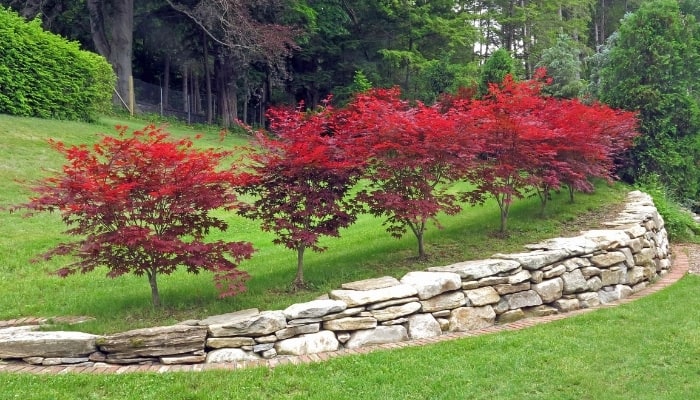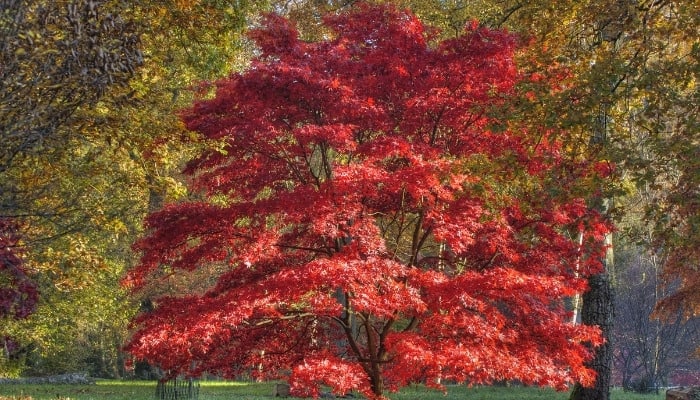If any difficulties arise while attempting to rephrase the text, please respond with the following error message: Unable to process the request due to encountered difficulties. Acer palmatum, also known as the Japanese maple, is famous for its stunning colors and beautiful foliage.
Native to Asia and Japan, this slow-growing deciduous tree is the pride and joy of many gardeners, providing a pop of autumn color in even the smallest garden.
Its popularity in the horticultural world means that providing the proper care and fertilizer to ensure its health is a top priority for every plant parent.
What is the best fertilizer for Japanese maples? For Japanese maples, slow-release granular fertilizers with low nitrogen levels are recommended. Fertilizer should be applied in late winter or after the last frost in spring. Standard lawn fertilizers should not be used as they contain too much nitrogen, which could weaken the tree.
To keep your Japanese maple thriving and vibrantly colored, you need to provide the appropriate care and fertilizer.
If you want to learn what fertilizer to use, when to use it, and how to apply it to your Japanese maple, read on.
Best Fertilizer for Japanese Maples
As a rule, fertilizers that work best for the Japanese maple are those low in nitrogen.
This tree is naturally slow growing, and while a sudden boost of nitrogen will speed up its growth, it can also weaken the tree.
Therefore, look for fertilizers that contain about three times more nitrogen than phosphorus. To do this, look at the NPK values on each product; these are usually three digits long and represent the nitrogen (N), phosphorus (P), and potassium (K) levels.
In addition, fertilizers that provide added benefits such as pest protection and additional nutrients are extremely beneficial.
Knowing what to look for in a fertilizer is instrumental to providing the best care for your Japanese maple. We have reviewed seven fertilizer products to take the guesswork out of this process.
1. BioAdvanced Protect & Feed
This ready-to-use slow-release nitrogen fertilizer feeds and protects from pests for 12-months with a single application.
Suitable for trees planted in the garden or containers, it contains 1.1% Imidacloprid (systemic insecticide) and protects against aphids, borers, and Japanese beetle.
Add the granules directly to the soil for root absorption. NPK analysis is 2-1-1.
2. Osmocote Plus Smart Release
Osmocote fertilizer consists of small resin-coated granules that release nutrients into the soil over time when they come into contact with water.
Granules are applied directly to the ground, and frequent watering is advised to encourage nutrient release. This fertilizer provides food for up to 6 months and contains 11 essential nutrients.
These include nitrogen, phosphate, soluble potash, sulfur, boron, copper, iron, manganese, molybdenum, and zinc. NPK analysis is 15-9-12.
3. Fox Farm Happy Frog Japanese Maple Fertilizer
This is a granular fertilizer that supports growth in cool weather conditions.
It has low nitrogen levels of 4% and includes additional nutrients derived from organic sources such as bat guano, feather meal, and cottonseed meal.
It also contains humic acid, which enhances the absorption of micronutrients and promotes seed germination. Apply this fertilizer monthly during the growing season. NPK analysis is 4-8-5.
4. Miracle-Gro Shake ‘n Feed
Miracle-Gro contains natural ingredients that support soil microbes; these include kelp, bone meal, feather meal, and earthworm castings.
It provides food for three months with one application. The nitrogen content sits at 12%, and the fertilizer provides essential micronutrients required for healthy growth and vibrancy.
NPK analysis is 12-4-8.
5. The Andersons PGF Balanced Fertilizer
While this fertilizer promotes growth and flowering, it also contains quick-release nitrogen, which can weaken the slow-growing Japanese maple if applied in excess.
Nevertheless, the packaging states it’s an excellent fertilizer for lawns, gardens, trees, and vegetables. Note that it contains equal amounts of nitrogen and phosphorus with an NPK analysis of 10-10-10.
6. Ferti-lome Tree and Shrub Food
This fertilizer has a nitrogen content of 19% and is suitable for tropical tree types, palms, shade trees, and fruit trees.
Due to the higher nitrogen content, this fertilizer should be used sparingly and is not recommended for container trees.
It should be applied directly to the ground twice a year. NPK analysis is 19-8-10.
7. Miracle-Gro Tree & Shrub Plant Food Spikes
Fertilizer spikes are convenient as they can be pushed into the ground near the root zone, eliminating the need to dig holes or mix fertilizer solutions/teas.
These spikes contain natural ingredients and are perfect for acid-loving trees such as the Japanese maple. NPK analysis is 10-5-10.
Fertilization Guide for Japanese Maples
While purchasing the right fertilizer is essential for keeping your Japanese maple vibrantly beautiful, it is equally important to know when and how to apply it.
Applying too much fertilizer too frequently can seriously impact the health and growth of your tree.
When To Fertilize Japanese Maples
Apply a slow-release or controlled release fertilizer in late winter or after the final frosts in spring.
This encourages slow, methodical growth and allows the Japanese maple to develop studier stems and vibrant foliage.
Where To Apply Fertilizer for Japanese Maples
Slow release granular/pellet fertilizers should be applied midway between the truck and the drip line of the branches.
Scattering fertilizer on top of the soil is not recommended as this can impact the effectiveness of the fertilizer.
Instead, dig a few small holes between the drip line and trunk, and put the fertilizer into each. Remember to divide the appropriate dosage equally between the fertilizer holes.
Then, backfill the holes with soil, and water the ground around the tree.
How Often To Fertilize Japanese Maples
The Japanese maple is not a heavy feeder and prefers a constant low-level supply of nutrients. If you follow the above fertilizing steps, the tree will have sufficient nutrients for 12 months.
Ensure the fertilizer you use has a low nitrogen content as this will prevent sudden growth spurts that can weaken the tree.
When Not To Fertilize Japanese Maples
Don’t be tempted to fertilize the Japanese maple too early. Most new trees only require feeding in their second year (growing season).
Feeding should be done in the late spring after the last frosts of late winter as unexpected freezes can cause damage to the tree’s new growth.

Related Questions:
How Far Should a Japanese Maple Be Planted From a House?
Planting a Japanese maple too close to a house can negatively impact root development and growth.
This is because the root system typically extends 5-20 feet beyond the branch line as the roots hunt for nutrients and water.
Small dwarf varieties should be positioned no closer than 6 feet from a house foundation, pathway, or driveway. This distance should be increased for larger cultivars.
How Long Do Japanese Maples Take To Grow?
Japanese maples are slow-growing deciduous trees that typically grow between 1-2 feet per year.
They can take anywhere from 7 to 10 years to reach maturity; however, reaching their maximum height can take up to 20 years or more.
When purchasing your Japanese maple, ask the nursery or supplier to confirm its maximum height and growth rate.
Conclusion
The eye-catching Japanese maple makes a stunning focal point in any garden. Its beautiful foliage, vibrant colors, and easy growing habits make it popular among gardeners in many regions.
Slow growth is the Japanese maple’s secret to attractive foliage and healthy growth.
Therefore by ensuring it receives a constant low-level supply of nutrients, you can ensure it continues to fill your garden with fabulous fall color displays.

